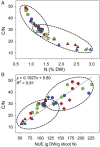Excreting and non-excreting grasses exhibit different salt resistance strategies
- PMID: 24996428
- PMCID: PMC4224665
- DOI: 10.1093/aobpla/plu038
Excreting and non-excreting grasses exhibit different salt resistance strategies
Abstract
The combination of traits that makes a plant successful under saline conditions varies with the type of plant and its interaction with the environmental conditions. Knowledge about the contribution of these traits towards salt resistance in grasses has great potential for improving the salt resistance of conventional crops. We attempted to identify differential adaptive response patterns of salt-excreting versus non-excreting grasses. More specifically, we studied the growth, osmotic, ionic and nutrient (carbon/nitrogen) relations of two salt-excreting (Aeluropus lagopoides and Sporobolus tremulus) and two non-excreting (Paspalum paspalodes and Paspalidium geminatum) perennial C4 grasses under non-saline and saline (0, 200 and 400 mM NaCl) conditions. Growth and relative growth rate decreased under saline conditions in the order P. geminatum > S. tremulus = A. lagopoides > P. paspalodes. The root-to-shoot biomass allocation was unaffected in salt-excreting grasses, increased in P. paspalodes but decreased in P. geminatum. Salt-excreting grasses had a higher shoot/root Na(+) ratio than non-excreting grasses. K(+), Ca(2+) and Mg(2+) homoeostasis remained undisturbed among test grasses possibly through improved ion selectivity with rising substrate salinity. Salt-excreting grasses increased leaf succulence, decreased ψs and xylem pressure potential, and accumulated proline and glycinebetaine with increasing salinity. Higher salt resistance of P. paspalodes could be attributed to lower Na(+) uptake, higher nitrogen-use efficiency and higher water-use efficiency among the test species. However, P. geminatum was unable to cope with salt-induced physiological drought. More information is required to adequately document the differential strategies of salt resistance in salt-excreting and non-excreting grasses.
Keywords: C–N balance; Na+ flux; compatible solutes; halophytic grasses; ion homoeostasis; nitrogen-use efficiency..
Published by Oxford University Press on behalf of the Annals of Botany Company.
Figures








Similar articles
-
Differences in photosynthetic syndromes of four halophytic marsh grasses in Pakistan.Photosynth Res. 2017 Jan;131(1):51-64. doi: 10.1007/s11120-016-0296-0. Epub 2016 Jul 23. Photosynth Res. 2017. PMID: 27450569
-
The Photosynthesis, Na(+)/K(+) Homeostasis and Osmotic Adjustment of Atriplex canescens in Response to Salinity.Front Plant Sci. 2016 Jun 17;7:848. doi: 10.3389/fpls.2016.00848. eCollection 2016. Front Plant Sci. 2016. PMID: 27379134 Free PMC article.
-
Structural diversity in salt excreting glands and salinity tolerance in Oryza coarctata, Sporobolus anglicus and Urochondra setulosa.Planta. 2022 Dec 8;257(1):9. doi: 10.1007/s00425-022-04035-6. Planta. 2022. PMID: 36482224
-
The influence of genes regulating transmembrane transport of Na+ on the salt resistance of Aeluropus lagopoides.Funct Plant Biol. 2013 Aug;40(9):860-871. doi: 10.1071/FP12346. Funct Plant Biol. 2013. PMID: 32481156
-
Potential use of halophytes to remediate saline soils.Biomed Res Int. 2014;2014:589341. doi: 10.1155/2014/589341. Epub 2014 Jul 6. Biomed Res Int. 2014. PMID: 25110683 Free PMC article. Review.
Cited by
-
Differences in photosynthetic syndromes of four halophytic marsh grasses in Pakistan.Photosynth Res. 2017 Jan;131(1):51-64. doi: 10.1007/s11120-016-0296-0. Epub 2016 Jul 23. Photosynth Res. 2017. PMID: 27450569
-
Phosphorus Limitation Improved Salt Tolerance in Maize Through Tissue Mass Density Increase, Osmolytes Accumulation, and Na+ Uptake Inhibition.Front Plant Sci. 2019 Jul 3;10:856. doi: 10.3389/fpls.2019.00856. eCollection 2019. Front Plant Sci. 2019. PMID: 31333699 Free PMC article.
-
Chemical Derivatization of Metabolite Mass Profiling of the Recretohalophyte Aeluropus lagopoides Revealing Salt Stress Tolerance Mechanism.Mar Biotechnol (NY). 2017 Jun;19(3):207-218. doi: 10.1007/s10126-017-9745-9. Epub 2017 May 19. Mar Biotechnol (NY). 2017. PMID: 28527016
-
Role of sodium ion transporters and osmotic adjustments in stress alleviation of Cynodon dactylon under NaCl treatment: a parallel investigation with rice.Protoplasma. 2018 Jan;255(1):175-191. doi: 10.1007/s00709-017-1138-4. Epub 2017 Jul 15. Protoplasma. 2018. PMID: 28710664
References
-
- Abideen Z, Koyro H-W, Huchzermeyer B, Ahmed MZ, Gul B, Khan MA. Moderate salinity stimulates growth and photosynthesis of Phragmites karka by water relations and tissue specific ion regulation. Environmental and Experimental Botany. 2014;105:70–76.
-
- Ahmed MZ, Shimazaki T, Gulzar S, Kikuchi A, Gul B, Khan MA, Koyro H-W, Huchzermeyer B, Watanabe KN. The influence of genes regulating transmembrane transport of Na+ on the salt resistance of Aeluropus lagopoides. Functional Plant Biology. 2013;40:860–871. - PubMed
-
- Albert R. Salt regulation in halophytes. Oecologia. 1975;21:57–71. - PubMed
-
- Bates L, Waldren R, Teare I. Rapid determination of free proline for water-stress studies. Plant and Soil. 1973;39:205–207.
-
- Bell HL, O'Leary JW. Effects of salinity on growth and cation accumulation of Sporobolus virginicus (Poaceae) American Journal of Botany. 2003;90:1416–1424. - PubMed
LinkOut - more resources
Full Text Sources
Other Literature Sources
Miscellaneous

